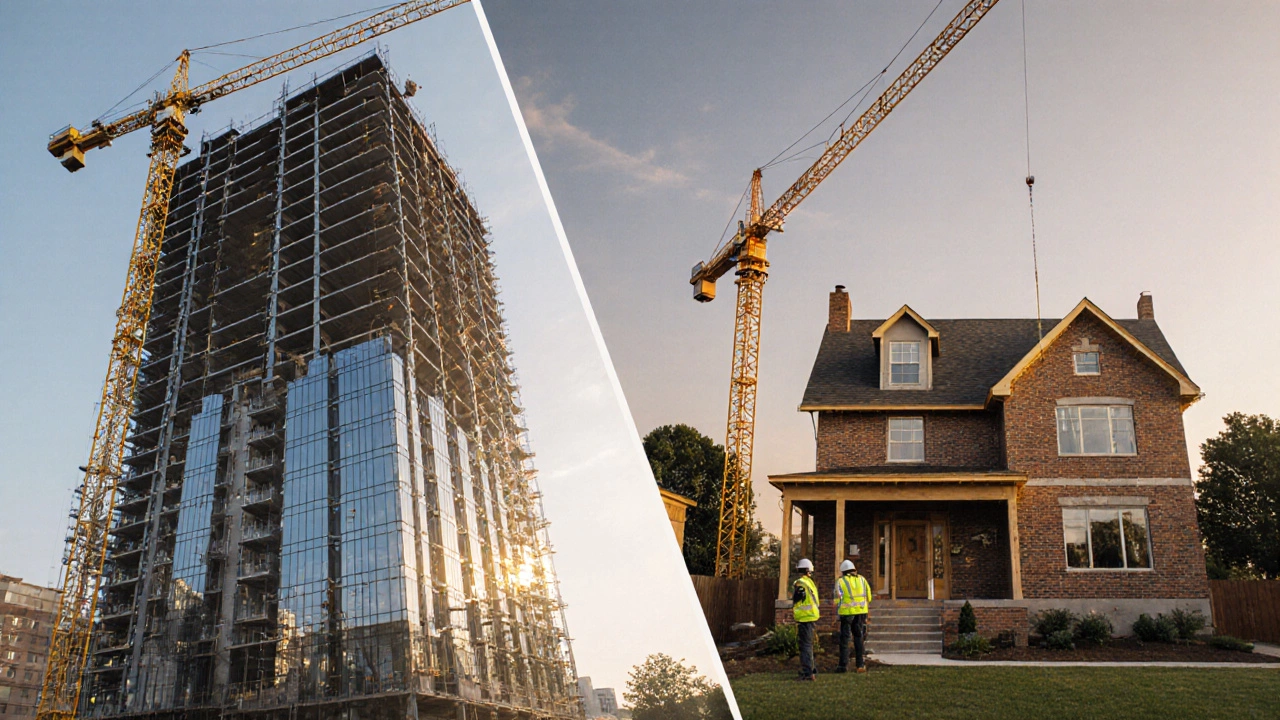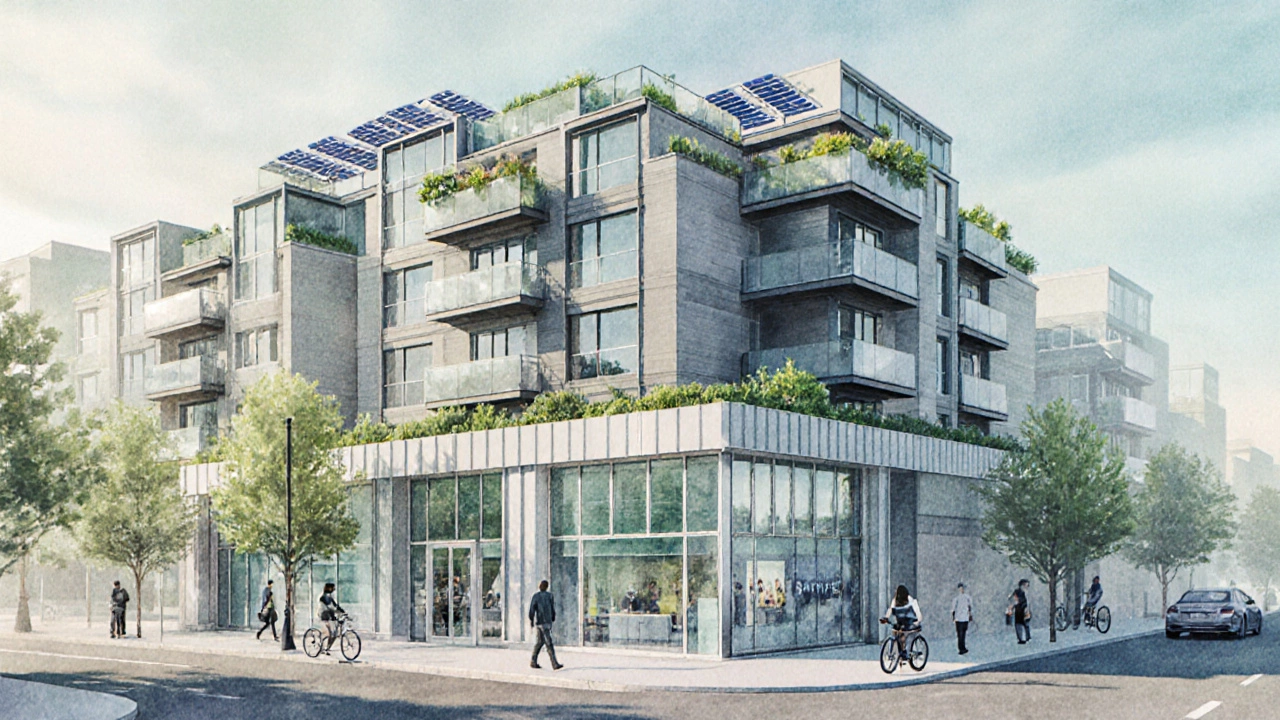What Is the Opposite of Commercial Construction? Explained
 Oct, 21 2025
Oct, 21 2025
Commercial vs Residential Construction Decision Tool
Determine Your Project Type
Answer these questions to find out if your project is more likely commercial or residential construction. This tool will analyze key attributes including purpose, funding, code requirements, and design priorities.
Project Analysis Result
Commercial Characteristics
Residential Characteristics
Key Differences
Commercial construction typically involves business use, corporate funding, and IBC compliance, while residential construction focuses on personal living spaces, mortgage financing, and IRC standards.
When you hear the phrase "opposite of commercial construction," most people instantly think of houses, apartments, and other places where families live. That intuition is spot on, but the reality goes a bit deeper. In the construction world, the true opposite of commercial construction is residential construction, a sector with its own set of rules, financing models, and design priorities. This guide walks you through what each side looks like, why they’re considered opposites, and how the differences affect everyone from developers to homeowners.
Defining Commercial Construction
Commercial construction is a branch of the building industry that focuses on structures intended for business activities, such as offices, retail centers, hotels, and industrial facilities. It typically involves larger floor plates, higher ceilings, and stricter fire‑safety standards. These projects are funded by corporate investors, banks, or public‑private partnerships and are governed by a distinct set of building codes and zoning rules that prioritize accessibility, durability, and occupant density.
Defining Residential Construction
Residential construction covers any building activity that creates living spaces for individuals or families. This includes single‑family homes, townhouses, condominiums, and multi‑unit apartment complexes. The focus here is on comfort, aesthetics, and energy efficiency rather than maximizing square footage for commercial revenue. Financing usually comes from mortgages, personal loans, or developer equity, and the regulatory environment leans heavily on zoning that separates neighborhoods from commercial zones.
Key Differences at a Glance
| Attribute | Commercial Construction | Residential Construction |
|---|---|---|
| Typical Projects | Office towers, shopping malls, warehouses | Single‑family homes, condos, apartment blocks |
| Funding Sources | Corporate equity, commercial loans, investors | Mortgages, personal loans, developer equity |
| Design Complexity | High - MEP (mechanical, electrical, plumbing) integration, large‑scale structural systems | Moderate - Focus on interior layout, energy‑efficiency measures |
| Building Codes | International Building Code (IBC), ADA compliance | International Residential Code (IRC), local zoning |
| Typical Timeline | 12‑36 months for medium projects, longer for skyscrapers | 4‑12 months for most homes, longer for high‑rise condos |
| Average Cost per Sq ft | $200‑$500 (varies by use and location) | $100‑$250 (varies by finish level) |
Why They’re Considered Opposites
- Purpose: Commercial buildings aim to generate revenue through business activities, whereas residential structures provide private living space.
- Regulatory Lens: Commercial projects must meet stricter fire safety, accessibility, and load‑bearing standards, while residential projects focus more on habitability and energy codes.
- Financing Model: Investors in commercial construction look for return on investment (ROI) over years, while residential buyers often prioritize personal equity and mortgage affordability.
- Design Priorities: Commercial architects balance functionality with brand image; residential architects balance comfort, aesthetics, and resale value.
Common Misconceptions
Many people assume that “commercial” simply means “big” and “residential” means “small.” In reality, size isn’t the defining factor. A boutique hotel (commercial) can be smaller than a sprawling suburban subdivision (residential). Likewise, a high‑rise office tower may share many structural elements with a high‑rise condo, but the interior fit‑out, fire‑egress design, and occupancy calculations differ dramatically.
How Zoning Separates the Two Worlds
Local governments use zoning maps to keep commercial activities away from quiet neighborhoods. A Zoning regulation might label a block as “R‑1” (single‑family residential) or “C‑2” (general commercial). Understanding these designations is crucial for developers; building a warehouse in an R‑1 zone could trigger costly variances or legal challenges.

Impact on the Workforce
Both sectors rely on skilled trades, but the skill sets differ. General contractors on commercial jobs often coordinate large crews of steel erectors, HVAC specialists, and fire‑protection engineers. Residential projects may involve more carpenters, finish‑carpentry crews, and interior designers. Workers who can switch between the two markets enjoy higher job stability, especially during economic cycles that favor one sector over the other.
Choosing a Path: Developer or Homeowner?
If you’re a developer weighing whether to pursue a commercial or residential project, ask yourself these questions:
- What is the demand in the target market? Retail vacancy rates versus housing shortages.
- Do I have access to the appropriate financing? Commercial loans often require larger down payments.
- Am I comfortable navigating the relevant building codes? IBC for commercial, IRC for residential.
- What is my risk tolerance? Commercial projects can yield higher returns but also higher exposure to market shifts.
For homeowners, the choice isn’t about sectors but about the type of residence that fits your lifestyle-single‑family, townhouse, or apartment. Understanding the “commercial vs residential” divide helps you see why certain neighborhoods have strict HOA rules (to preserve the residential character) while nearby business districts enjoy broader signage allowances.
Future Trends Shaping Both Sectors
- Modular Construction: Prefabricated modules are being adopted in both sectors, but commercial developers use them for rapid expansion of hotels and offices, while residential builders use them for affordable housing.
- Sustainability Standards: LEED certification, Net‑Zero goals, and passive‑house standards are now common in residential projects as well as high‑performance commercial office towers.
- Smart Building Technologies: IoT sensors for energy management started in commercial skyscrapers and are trickling down into smart homes.
- Mixed‑Use Developments: The line between commercial and residential is blurring as developers combine retail on the ground floor with apartments above. Even so, each portion still follows its own code set.
Quick Checklist: Spotting the Difference
- Is the primary use for business activity? → Commercial.
- Is the building intended for personal living? → Residential.
- Which code applies - IBC or IRC? → IBC = commercial, IRC = residential.
- What financing model is used? → Investor‑driven vs mortgage‑driven.
Conclusion: The Real Opposite
In construction jargon, the opposite of commercial construction isn’t “nothing” - it’s a whole ecosystem of residential building practices. While the two sides share materials, labor, and even some design principles, they diverge in purpose, regulation, financing, and market dynamics. Knowing the distinction empowers developers, contractors, and homeowners to make smarter decisions and avoid costly missteps.

Is industrial construction a third category?
Industrial construction focuses on facilities like factories, power plants, and logistics hubs. It shares many code requirements with commercial construction but often involves specialized equipment, higher load capacities, and stricter environmental permits.
Can a building be both commercial and residential?
Yes, mixed‑use developments combine commercial spaces (like retail or offices) with residential units. Each portion must meet its own code set, so designers often treat the two halves as separate projects under one master plan.
Do building permits differ between the two?
Absolutely. Commercial permits usually require detailed fire‑safety plans, accessibility studies, and higher fees. Residential permits focus more on habitability checks, such as insulation, plumbing, and egress windows.
Which sector typically offers higher profit margins?
Commercial projects can yield higher absolute profits because of larger scale, but they also carry more risk and longer payback periods. Residential projects usually have quicker turn‑around and more predictable cash flow, especially in high‑demand housing markets.
What’s the biggest regulatory hurdle for residential builders?
Zoning compliance is often the toughest. Even if a design meets the International Residential Code, a local zoning board can block a project if it exceeds height limits, density caps, or land‑use classifications.
